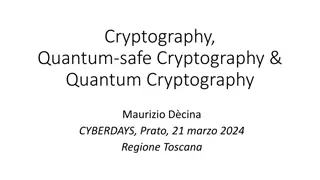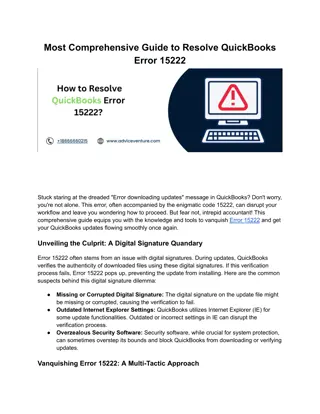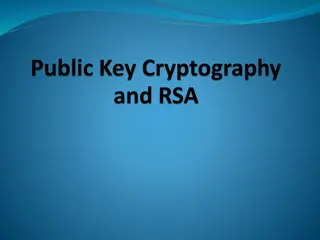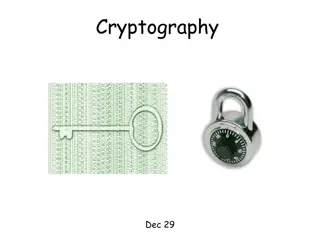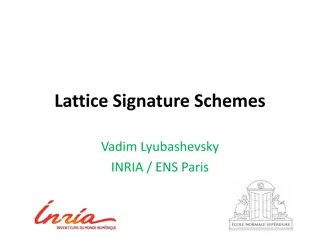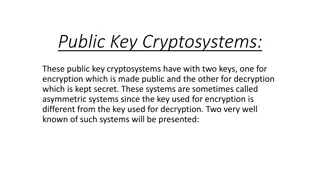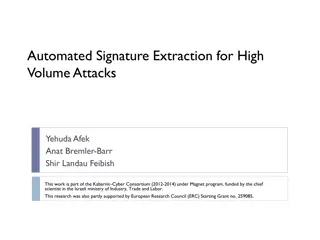Public Key Cryptosystems and Digital Signature Algorithms
Symmetric and asymmetric encryption methods, disadvantages of symmetric encryption, Diffie-Hellman key exchange, and the importance of key distribution. Understanding the significance of public key encryption and its application in secure data communication.
Download Presentation

Please find below an Image/Link to download the presentation.
The content on the website is provided AS IS for your information and personal use only. It may not be sold, licensed, or shared on other websites without obtaining consent from the author.If you encounter any issues during the download, it is possible that the publisher has removed the file from their server.
You are allowed to download the files provided on this website for personal or commercial use, subject to the condition that they are used lawfully. All files are the property of their respective owners.
The content on the website is provided AS IS for your information and personal use only. It may not be sold, licensed, or shared on other websites without obtaining consent from the author.
E N D
Presentation Transcript
PUBLIC KEY CRYPTOSYSTEMS AND THEIR APPLICATION IN DIGITAL SIGNATURE ALGORITHMS Prepared by Glushachenko N.S.
Symmetric encryption algorithms use a single secret key to encrypt and decrypt messages
Disadvantages: same key to encrypt and decrypt the message. However, securely sharing the key between the two parties can be difficult, especially if they are geographically distant or have different security policies. Key distribution: In symmetric cryptosystems, both the sender and receiver need to have the and then discarded or replaced with a new key. Managing a large number of keys can be challenging, especially if they are used across different systems or applications. Key management: Symmetric keys are typically used for a limited time (e.g., for a single session), Lack of non-repudiation: Symmetric encryption only provides confidentiality, but not authentication or non-repudiation. This means that the sender of a message cannot be verified, and the receiver cannot prove to a third party that the message was indeed sent by the claimed sender.
Asymmetric encryption uses a pair of keys: a public key and a private key. public key known to all users. It allows to encrypt a message or verify its author; private key, known only to the recipient. It is used to decrypt messages or create signatures.
Diffie and Hellman algorithm Diffie Hellman key exchange is a mathematical method of securely exchanging cryptographic keys over a public channel and was one of the first public-key protocols. Named after Whitfield Diffie and Martin Hellman. Published in 1976 by Diffie and Hellman.
Diffie and Hellman key distribution Step 1: 1. Select a large prime number q 2. Select number a, which will be a primitive element of the finite field GF(q) with q 1 unique elements *q and a can be intercepted, but this will not affect the efficiency of the encryption.
Diffie and Hellman key distribution Step 2: 1. Both users choose a secret number M in order to compute C. C is an element of GF(q) at M position. In this case, C is distributed through the open channel, which means that there is a possibility of interception by a hacker. C = aMmod q M = logaC mod q
Diffie and Hellman key distribution Step 3: 1. Calculate a key based on the C received from the recipient and their own C. With this method of key distribution there is no possibility of interception because it is not distributed over an open channel. K = aMi Mjmod q
Digital signatures There are three features that could be stated as the most important properties of such algorithms: anyone can verify the authenticity of the signature the possibility of forgery is excluded the author cannot refuse the signature.
One-way function A one-way function is a function for which obtaining an argument, knowing its value, is not possible in a reasonable amount of time with the current level of computing power. This means that it is easy to turn raw data into encrypted data, but impossible to do the opposite in a reasonable time. In digital signatures hash function is one-way function.
Hash function Hash functions are expected to meet the following requirements: the result of hash function must be significantly different for small changes in the original message, hash function must match each unique message with a unique hash, hash repetitions must be excluded.
Digital signatures Sender: 1. Calculate the hash of the original message using hash function. 2. Encrypt the hash using a secret key. The result is a digital signature. 3. Form a new message consisting of an original message and a digital signature added to it. Recipient: 1. Calculate the message hash using a hash function. 2. Using the public key, decrypt the digital signature and obtain the original hash. 3. Compare calculated value with hash value extracted from digital signature. If hashes match, the signature is considered authentic. It should be noted, that a digital signature can be realized based on symmetric algorithms as well, but such algorithms are applicable only for single-use signatures. It is connected with the fact that during verification of a signature the user receives half of encryption keys and later can forge the signature. This leads to the necessity to generate unique keys for each signature.
The importance of public key cryptosystems The importance of public key cryptosystems Message encryption E-mails Banking transactions Communications Digital signatures Digital cash


